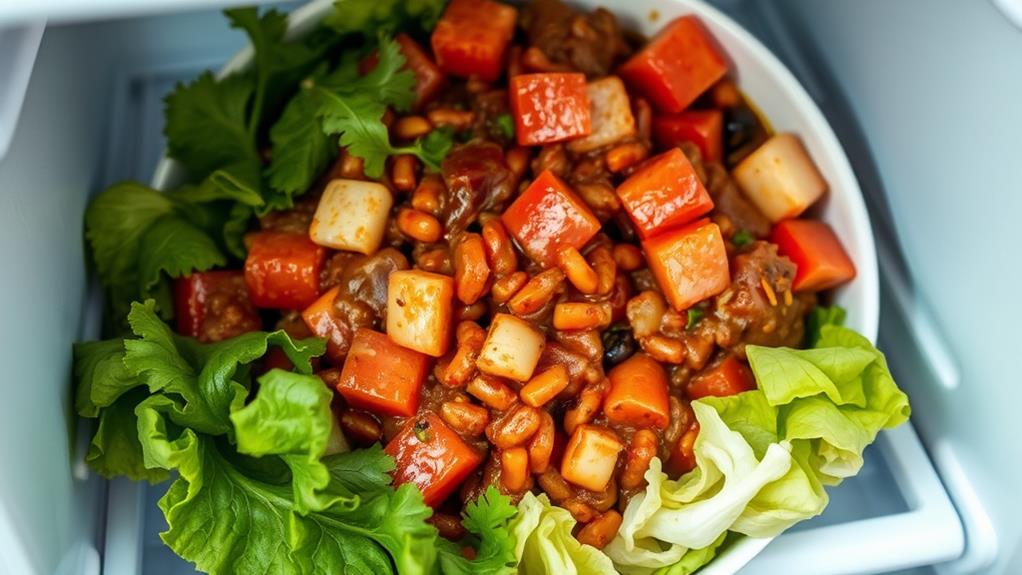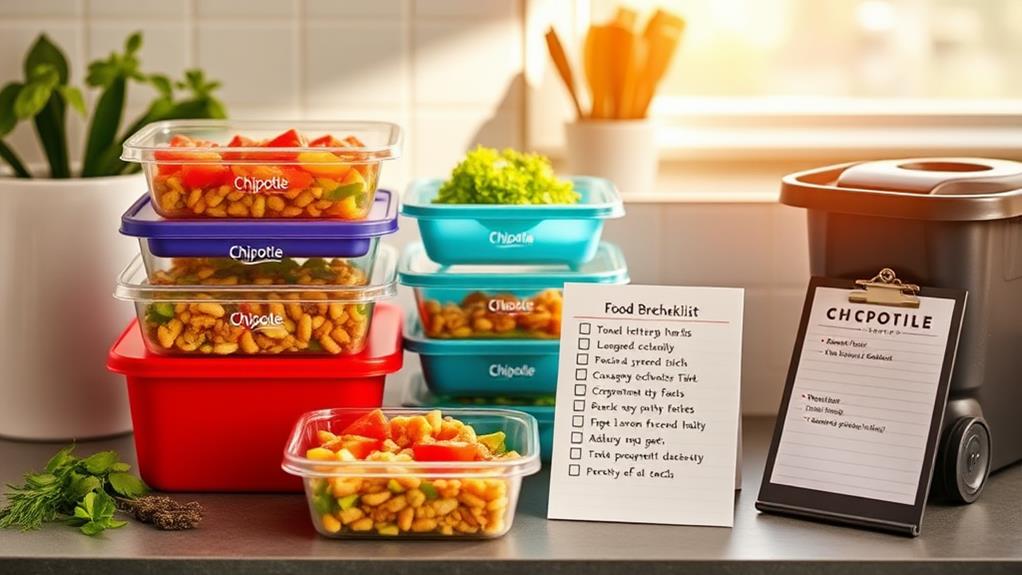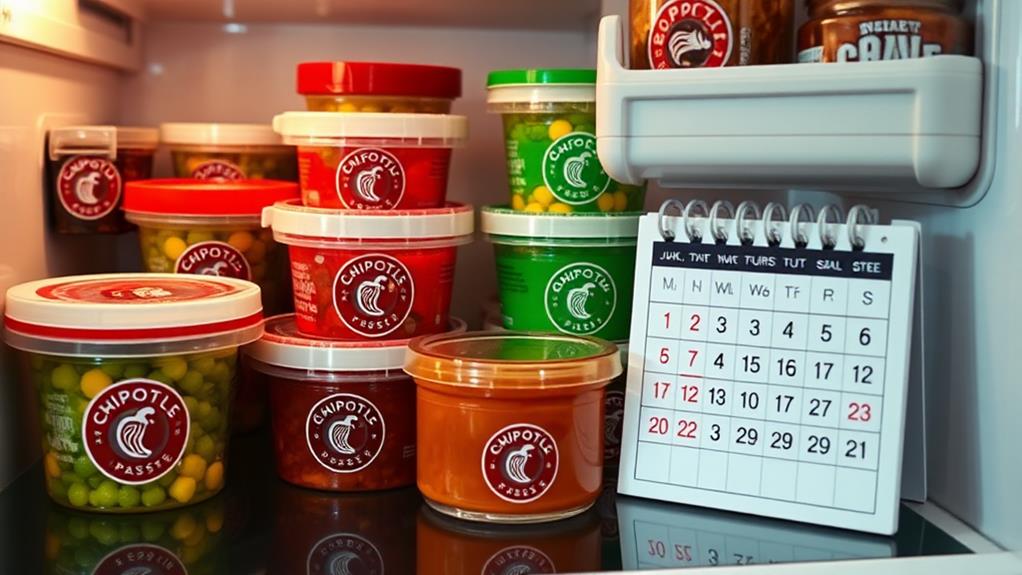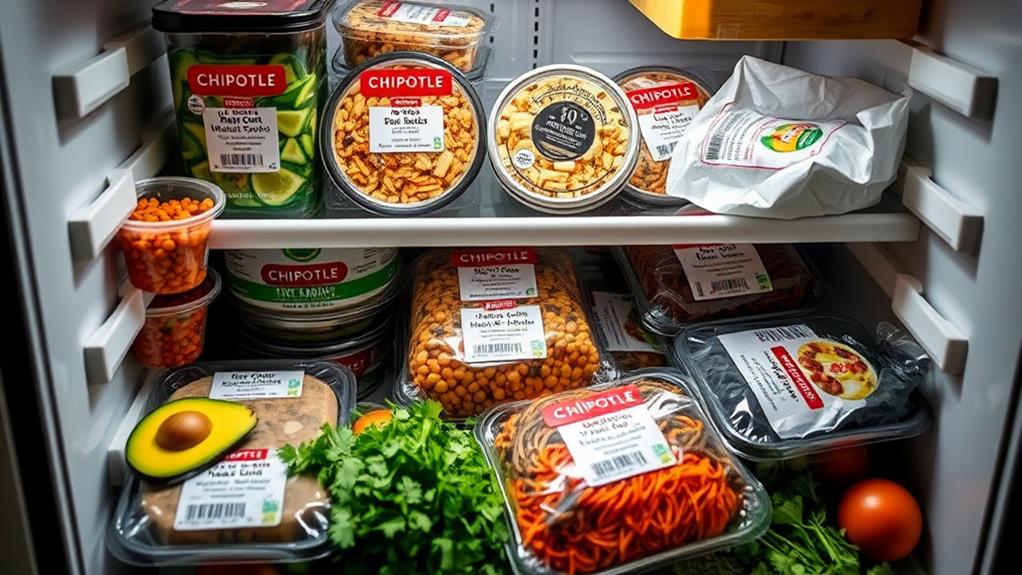Chipotle leftovers last about 3-4 days in the fridge if you store them properly. Use airtight containers to keep them fresh, and separate cooked ingredients from fresh toppings to maintain quality. Refrigerate your leftovers within two hours of serving to inhibit bacterial growth, and label your containers with storage dates. Always watch for signs of spoilage like off smells or mold, and throw away anything that seems off. If you want to maximize your leftovers and reduce waste, consider some creative uses for them that'll keep things exciting in your kitchen.
Understanding Chipotle Shelf Life
When it comes to understanding Chipotle's shelf life, knowing how to store your leftovers properly is key. When you keep your Chipotle dishes in airtight containers, they can last about 3-4 days in the refrigerator. To maintain the best quality, separate cooked ingredients from fresh toppings. This approach helps prevent spoilage and keeps your meal fresher for longer.
Additionally, utilizing tools like budgeting apps can help you save money by reducing food waste, as you'll be more aware of how much you have and when to consume it effective savings goal setting.
You should always be on the lookout for signs of spoilage. If you notice off smells, visible mold, or changes in texture or color, it's time to toss those leftovers. Consuming your Chipotle within the recommended time frame isn't just about taste; it's essential for food safety as well.
To avoid food waste, consider labeling your containers with dates. This simple step can help you track how long your Chipotle's been hanging around and remind you when it's time to dig in or say goodbye.
Proper Storage Techniques
To keep your Chipotle leftovers fresh and safe to eat, proper storage techniques are vital. Start by promptly refrigerating your leftovers within two hours of serving to inhibit bacterial growth and maximize shelf life.
For cold ingredients like fresh vegetables and guacamole, store them in separate airtight containers to maintain their freshness and prevent sogginess. Utilizing effective methods can be significant for expense tracking apps that help manage food costs efficiently.
Label each container with the date of storage so you can easily track how long your leftovers have been in the fridge. Aim to consume them within the recommended 3-4 days for ideal food safety.
When storing cooked items, such as chicken, beans, and rice, use separate containers to avoid cross-contamination and guarantee even reheating. This way, you can enjoy each component without compromising quality.
If you need to keep cold ingredients out temporarily, consider using ice-filled bowls to maintain safe temperatures.
Signs of Spoilage

Checking for signs of spoilage is essential for guaranteeing your Chipotle leftovers are safe to eat. First, pay attention to any sour or unusual odors coming from your chipotle sauce. These scents often indicate bacterial growth or fermentation, signaling that it's time to toss it.
Additionally, practicing ethical shopping habits can help you choose ingredients that are fresher and more sustainably sourced. Next, look for visible mold or significant color changes—both are clear indicators that the sauce should be discarded.
You should also check the texture of the sauce. If it appears thick, grainy, or separated, it's a strong sign of spoilage. Consuming spoiled sauce can lead to foodborne illness, so don't take any chances.
Finally, if you decide to sample a bit, be alert for an off or sour taste. If it doesn't taste fresh, it's best to throw it away.
Regular checks for these signs will help guarantee your chipotle sauce remains safe and tasty for consumption. By being vigilant, you can avoid unnecessary food waste and enjoy your leftovers with confidence.
Always remember: when in doubt, it's better to discard than risk your health!
Safe Reheating Methods
When you're ready to enjoy your leftover Chipotle, it's important to reheat it safely.
To guarantee you maintain the best flavor and texture, consider tracking your food storage timelines just like you'd with bills to avoid waste efficient food management.
You can choose between using the microwave for quick heating or the stovetop for better texture.
Just remember to remove any fresh toppings before you start!
Microwave Reheating Guidelines
Reheating your Chipotle leftovers in the microwave can be quick and convenient, but it's important to do it safely to preserve flavor and texture. Follow these microwave reheating guidelines to guarantee your meal is both delicious and safe.
Start by placing your food in a microwave-safe bowl and covering it loosely. This helps retain moisture and promotes even heating.
Heat your leftovers in one-minute intervals, stirring in between to guarantee uniform temperature distribution. This process typically takes about 2-3 minutes for most dishes. Always check that the internal temperature reaches at least 165°F (73.9°C) to meet food safety tips and guarantee it's safe for consumption.
Before you start reheating, remember to remove any fresh toppings like guacamole or lettuce, as they can become wilted or soggy in the microwave.
While the microwave is convenient, for best texture and flavor, you might consider reheating cooked ingredients on the stove over medium-low heat for 5-7 minutes instead. This method often results in a more satisfying dining experience.
Enjoy your reheated Chipotle!
Stovetop Reheating Techniques
To enjoy your Chipotle leftovers while preserving their deliciousness, stovetop reheating is a fantastic option. Start by using medium-low heat to gently warm your cooked ingredients for about 5-7 minutes. This method helps maintain the texture and flavor of your meal.
Before you begin, it's essential to separate fresh toppings like lettuce and guacamole. This prevents them from wilting or becoming soggy during reheating.
While your food warms, stir the ingredients occasionally. This guarantees even warming and reduces the risk of hot spots that could lead to uneven cooking. For better results, cover the pan with a lid. This traps steam, helping to warm the food effectively without drying it out.
When you think your meal is ready, always check that the internal temperature reaches at least 165°F (74°C) to confirm food safety.
Tips to Reduce Food Waste

Reducing food waste is essential for both your wallet and the environment, and there are several simple strategies you can adopt to make a difference.
One effective approach is to practice sustainable delivery practices by coordinating grocery deliveries with neighbors, which can minimize excess food purchases and encourage community sharing.
Here are some effective tips:
- Store leftovers in airtight containers to keep them fresh and safe.
- Label containers with the storage date to track how long food's been kept.
- Separate cooked ingredients from cold toppings to prevent sogginess.
- Plan meals ahead to minimize leftovers and avoid over-preparation.
Creative Ways to Use Leftovers
Leftovers from Chipotle can be a goldmine for creativity in the kitchen. Instead of letting your leftover Chipotle go to waste, think about transforming them into delicious meals. For a spicy breakfast, mix those flavorful bowl ingredients with scrambled eggs or whip up an omelet. It's a great way to kickstart your day!
Additionally, using digital coupons can help you save on ingredients when restocking your pantry for these creative meals.
If you're in the mood for a snack or appetizer, use leftover Chipotle proteins like chicken or beef as toppings for homemade nachos. Layer them with cheese, jalapeños, and your favorite salsa for a quick treat.
You can even get creative with lunch by blending leftover Chipotle ingredients into a smoothie or wrap, adding fresh greens and grains for a nutritious boost.
Feeling chilly? Make a hearty soup by simmering your leftover Chipotle with broth, beans, and vegetables for a wholesome meal that utilizes all components.
Lastly, don't overlook the classic quesadilla. Stuff tortillas with your leftover Chipotle fillings, add cheese, and grill until crispy for a satisfying dinner option.
These ideas guarantee your leftover Chipotle doesn't have to go to waste!
Frequently Asked Questions

When it comes to storing and enjoying your Chipotle leftovers, you might've some questions. Here are some frequently asked questions to help you out:
- How long does Chipotle last in the fridge? Properly stored, it can last 3-4 days. To maximize food safety and minimize waste, it's also important to keep track of your leftovers, similar to how businesses manage billing efficiency through clear payment terms.
- Should I separate ingredients? Yes, store cooked ingredients separately from cold ones to maintain freshness.
- How can I tell if it's spoiled? Check for off smells or visible mold before consuming.
- What's the best way to reheat leftovers? Make certain to reheat to an internal temperature of 165°F (74°C).
To store Chipotle effectively, label your containers with the date you put them in the fridge. This way, you can easily track their freshness and minimize food waste.
Remember, it's vital to be mindful of food safety. If you notice any signs of spoilage, it's best to err on the side of caution and throw it away.
Conclusion
In the dance of flavors that is Chipotle, savoring every bite is a joy that shouldn't end too soon. By storing your leftovers properly and keeping an eye out for signs of spoilage, you can stretch that delicious experience a little longer. Embrace the creativity of transforming yesterday's meal into something new, and you'll not only reduce waste but also turn mealtime into an adventure. After all, each bite is a memory waiting to be made.



